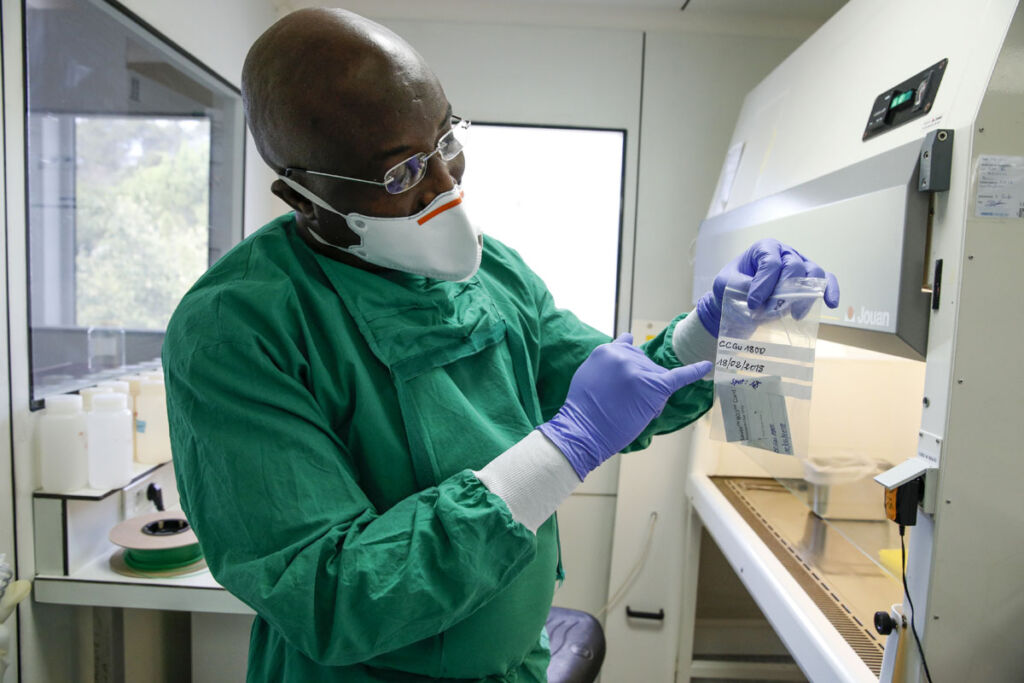[LUM#15] Ebola, still around?
Patients who continue to suffer more than four years after recovery, and a virus that plays hide-and-seek with our immune system. This is the subject of research conducted by Alpha Keita and Eric Delaporte with teams from TransVIHMI and CERFIG, who have highlighted a real paradigm shift in the transmission of the Ebola virus.

It's a word that sounds like the title of a B-movie disaster film: Ebola. A disease that fires the imagination of screenwriters, but weighs heavily on the daily lives of thousands of people. And one that can affect them for much longer than previously thought. This has been highlighted by Dr. Eric Delaporte and virologist Alpha Keita, researchers at the TransVIHMI laboratory. For more than four years, they have been following 722 survivors of the major Ebola epidemic that took place in West Africa between 2013 and 2016. Declared cured , "meaning that no virus was found in their blood," explains Alpha Keita, some of them still show signs of after-effects more than four years after their recovery.
Long Ebola
This cohort of patients, known as PostEboGui, was closely monitored by researchers from IRD, Inserm, the University of Montpellier, the University of Conakry, and Cerfig (Center for Research and Training in Infectious Diseases in Guinea), who found symptoms in 1 in 3 patients. Headaches, dizziness, fever, fatigue, anorexia, abdominal or musculoskeletal pain, anxiety, depression... the list of symptoms of what researchers now consider to be "long Ebola" – by analogy with long Covid – is just as long.
"These symptoms are of several types," explains Eric Delaporte. " They may be related to post-traumatic syndrome or directly to the virus attack and the damage it has caused to the body." But they can also be caused by the virus nesting in specific areas of the body, such as the eyes, joints, or brain, where it persists long after recovery, causing chronic inflammation that leads to long-term pain. "These are known as immune privileged sites because they are places where antibodies do not intervene, " explains Eric Delaporte.
Immune hide-and-seek
Well hidden, the Ebola virus can therefore persist in the body for years... And emerge from its hiding place whenever it wants? In any case, this is what may have led to the new Ebola epidemic that broke out in Guinea in February 2021. To determine the origin of this new epidemic, researchers analyzed the genome of the virus taken from patients and obtained surprising results. "We found that it was very similar to the one that caused the epidemic that ended in 2016, which means that the 2021 epidemic was caused by the resurgence of a persistent source, most likely a human host in whom the virus had remained hidden all this time," adds Alpha Keita.
This represents a real paradigm shift for researchers, because "for a long time, it was thought that with each new epidemic, the virus was introduced into the population through contact with wildlife, passing from animals to humans, " explains Eric Delaporte.
The virus, safely hidden in these viral reservoirs, could cause a relapse years later in a patient considered cured. It could even be transmitted by these "healthy carriers" to other individuals who will then develop the disease. "The testicles are another immune-privileged site, meaning Ebola can be transmitted sexually. We have already documented a case where a survivor clearly transmitted the virus to his partner via semen, months after he had been declared cured, " adds Eric Delaporte.
Stigmatization
These revelations, which shed new light on these epidemics, must nevertheless be treated with great caution, according to the researchers. "None of this allows us to conclude that it was specifically an Ebola survivor who caused this new epidemic," they caution. "It could just as easily have started with an asymptomatic patient." This is a crucial point, given that Ebola survivors are already victims of stigmatization: "They can lose their jobs, their homes, and are sometimes even rejected by their communities, a stigma that risks being further exacerbated if this issue is not communicated properly, " emphasizes Eric Delaporte. "In Guinea, 16% of individuals have antibodies against Ebola. As far as we know, anyone could be considered the starting point of this epidemic, " concludes Alpha Keita.
These unprecedented findings suggest that Ebola patients should be monitored long after their recovery. "Long-term sequelae can have a major negative impact on survivors' health, quality of life, and ability to work. It is important to continue to monitor them over the long term, not only to improve their care but also to prevent possible resurgence of the virus, " concludes Eric Delaporte.
International response
What is the prognosis for a patient infected with Ebola? "For a long time, it was thought that Ebola infection was always fatal, " recalls Dr. Eric Delaporte. This disease, which begins with simple feverish diarrhea, can indeed progress to hemorrhagic syndrome and fatal damage to all organs. "But that was before the major epidemic of 2013," explains the researcher from the TransVIHMI laboratory. " The fear of the virus spreading across the globe prompted an international response. Finally, resources were allocated and research progressed considerably. We now have a vaccine, as well as effective treatments based on anti-Ebola monoclonal antibodies."
Find UM podcasts now available on your favorite platform (Spotify, Deezer, Apple Podcasts, Amazon Music, etc.).